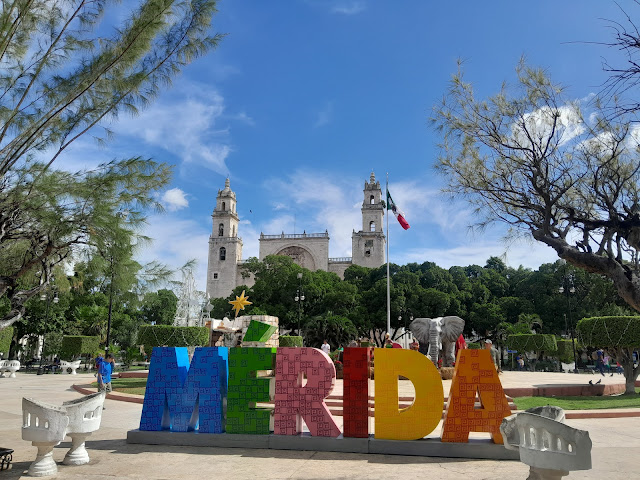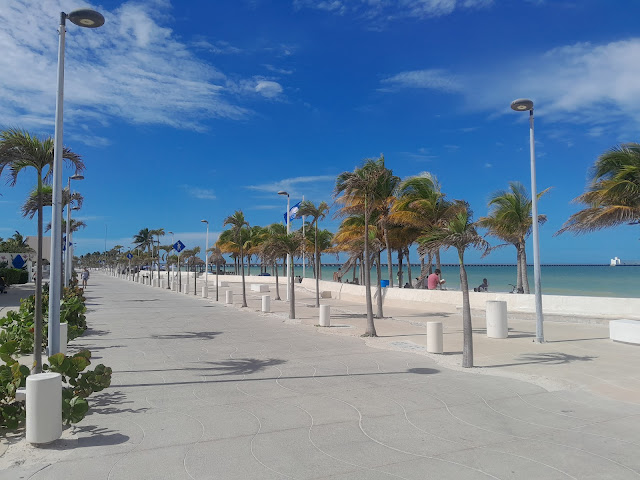Mexico is a federal country, divided up into 31 states, with Mexico City as a separate entity (not unlike Washington DC in the USA). South of Mexico City lies the state of Morelos, and its capital is Cuernavaca. Only a couple of hours on the bus from the capital.
Multiple factors line up to make this part of the world a bit more spicy than what I'm used to. Travelling in, you see army patrols stationed at intervals, machine guns mounted on the backs of their trailer trucks. They're not just for show. Outside my hotel, at night, I could see occasional coyotes scampering around the car park: at one point in the small hours I was awakened by a very noisy confrontation between the coyotes and the stray cats, from which I don't think all survived to tell the tale. And there was a magnitude 5.8 earthquake here just a couple of days after I left.
Looking on the brighter side, the hotel is nice, and the altitude is about 1500m: higher than Ben Nevis, but still a good 700m lower than Mexico City, so there's a bit more oxygen. Also a bit less pollution. I do miss the cool sea breezes of home, but on the other hand it's nice and sunny and warm here, and I don't miss the winter blues. Obviously I'm in for a shock when I get home (spoiler alert: within the next couple of weeks or so).
Random facts of Mexican life #1: this is not a country for coffee snobs. Quite a few places, including some branches of McDonald's, don't know what an espresso is and can't provide one. It's half a pint of murky water, or nothing. Here in Cuernavaca, I went for a sandwich and the accompanying coffee was served in the form of a mug of plain water, freshly-boiled, with a jar of instant granules on the side. The idea being that you add the granules to the water as required. This would be unthinkable anywhere in Spain, and also (nowadays) in the UK pretty much anywhere other than a truck stop. In fairness the sandwich was very nice.
Random facts of Mexican life #2: there are some important differences between Mexican Spanish and Spanish Spanish. The most salient is the verb coger: in Spanish Spanish, it generally means to "take" or to "pick up", in the sense of a bus or a train, or a Greggs sausage roll. But in Latin America it means, and let's put this politely, to engage in the act of procreation. Also there's the Mexican exclamation qué padre!, a positive evaluation that translates very roughly as "it's the daddy". This means nothing in Spain. And it's a good example of the sexism inherent in the Spanish language, because any time an exclamation includes the word madre, ie mother, it's most likely expressing something along the lines of, ahem, coger.
Random facts of Mexican life #3: did you know that the letter W, ie "double-U", is also called "double-U" in Mexico, but "double-V" in Argentina and "V-double" in Spain?
Random facts of Mexican life #4: everybody has stopped reading, so it's probably best that I stop writing.
 |
Pool at the hotel.
While I was occupying one of the deckchairs on the right hand side, a bird pooped on me.
"Fortune vomits on my eiderdown once more..." |
 |
"Graduations D'Ox-ford"
Not convincing. |
 |
| Little league baseball (girls) in the northern suburbs |
 |
| Cuernavaca cathedral |
 |
| Palace of Cortés, begun in 1531, now a museum |
 |
Teopanzolco
Aztec archaeological site not far from the city centre. 1300-1521AD.
Human sacrifices were performed here en masse. Also it's not really all that old.
It's interesting, but I wouldn't say it's anything to admire. |
 |
Edd vs Food #135
Cooked breakfast, Mexican style: scrambled eggs with bacon bits (tocino) and refried beans.
At Los Colorines de Cuernavaca |































